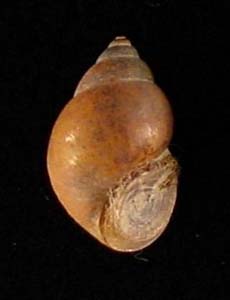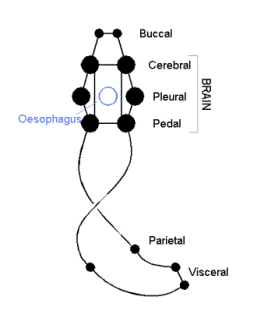
Adaptation
B. tentaculata is very well
adapted to its habitat and lifestyle. Adaptations can come in many
forms such as adapting to predators by feeding on the sides of rocks
instead of the top or or the evolution of the open circulatory
system which suits the needs of the faucet snail.

The faucet snail can be a food item for the common carp (Cyprinus carpio), waterfowl, as well as predatory crayfish and leeches (Kipp and Benson 2010). They can sense the presence or absence of predators, often by chemoreception, and they respond accordingly by closing its operculum or hiding under substrates if time permits (Kipp and Benson 2010). The operculum is a calcareous plate attached to the dorsal posterior foot and closes the aperture when the snail withdraws into its shell (Mitchell and Cole 2008). It is tear-drop to oval-shaped with distinct concentric rings in adults and spirally marked in juveniles (Kipp and Benson 2010). Not all snails have an operculum but it is a very useful adaptation for B. tentaculata. When the operculum closes the aperture, the the mantle cavity is sealed off allowing increased protection of the faucet snail from chemicals and desiccation (Mitchell and Cole 2008). Experiments done by Andrew Mitchell of the U.S. Department of Agriculture and Rebecca Cole of the U.S. Geological Survey have showed high resistance of the faucet snail to ethanol, NaCl, formalin, Lysol, potassium permanganate, copper sulfate, Baquacil, Virkon, household bleach, and pH extremes (as low as 1 and as high as 13); as well as the ability to withstand desiccation for longer than 8 days in a dry container at 21ºC.
Another adaptation in B. tentaculata is the evolution of true nervous system tissue, which is ganglia in gastropods. Ganglia is what allows for the integration of and response to sensory signals received through photoreceptors, chemoreceptors and mechanoreceptors. While the gastropod nervous system is not the most complex, it serves its purpose for the lifestyle of the faucet snail. Its central nervous system allows these snails to respond quicker with more complex, purposeful movements, such as closing its operculum to escape predators. Quicker response is due to cephalization with clusters of ganglia creating a 6-lobed brain. In B. tentaculata, one specific lobe is responsible for a lot of the development of the snail (Cather and Verdonk 1974). This lobe is called the polar lobe and it is responsible for establishing bilateral symmetry, and forming the eyes, foot, operculum and shell (Cather and Verdonk 1974). A specific ganglia of the nervous system, the buccal ganglia, is responsible for controlling the radula, a feeding structure which is very important in gastropod nutrition. Another important ganglia, the visceral ganglia, is is responsible for receiving information from the viscera or organs of the faucet snail.
-
Heartbeat seen through shell (Pomacea canaliculata)
<----Not B. tentaculata but interesting!
![]()
Since B. tentaculata has visceral tissue it also needs a circulatory system to provide nutrients to its viscera. The faucet snail has an open circulatory system, which means the blood (called hemolymph) travels through arteries and veins but instead of traveling through capillaries, the hemolymph “bathes” the organs in sinuses (Ghesquiere 2007). The hemolymph also functions as a hydroskeleton in gastropods, providing support for extension movements (Ghesquiere, 2007). This system is not the most efficient at nutrient and waste transfer, but the sedentary lifestyle of the snail allows it to work well for them, therefore being a beneficial adaptation.
Another adaptation in all gastropods is that they have undergone torsion or “the visceropallium (shell, mantle, mantle cavity with contained structures, and viscera) rotated by 180° relative to the head and foot”(Page 2006). There are two hypotheses as to how gastropods have changed so dramatically; the “rotation hypothesis and the asymmetry hypothesis” (follow the link for more information) (Page 2006). Torsion is an advantage to gastropods because the mantle cavity is now near the head of the snail and allows them to withdrawal their head into the mantle cavity and the mantle cavity receives more consistent ventilation of the gills.
Return to the Home page

